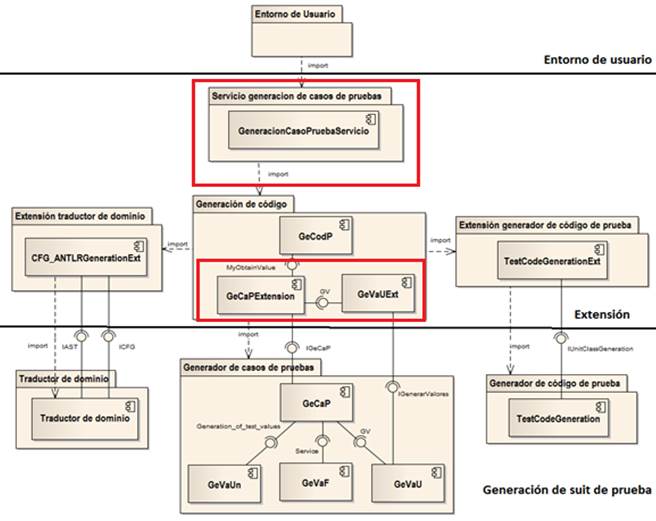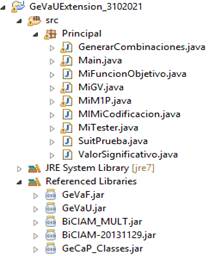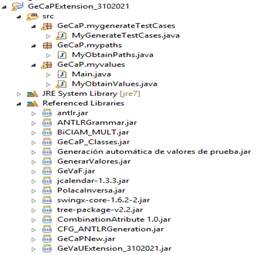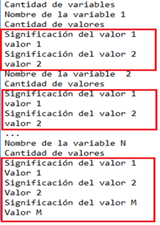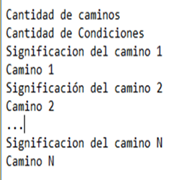Introduction
Software testing is the phase of the life cycle of software development whose objective is to discover the failures that have occurred in the rest of the phases, so that they can be solved, thus contributing to the quality of the product and reducing the cost derived from such failures (PRESSMAN, 2015). However, software testing is expensive (MYERS, 2012). Due to this, it is necessary to automate the testing process in order to reduce its cost and increase its effectiveness (MYERS, 2012) (OLIINYK, 2019) (SERNA, 2019).
Within the dynamic testing processes are included the activities of design and execution of tests (PRESSMAN, 2015). One of the activities that entail an intensive labor is the generation of combinations of test values used in the construction of the test cases of the software product in the design stage (FERNÁNDEZ, 2016) (SERNA, 2017) (FELBINGER, 2018).
There are several methods for the automatic generation of test data, which try to efficiently find a small set of such data that allows satisfying a given sufficiency criterion (FERNÁNDEZ, 2016) (SERNA, 2017) (ZHANG, 2020). This reduces the cost of software testing (MYERS, 2012) (BLÉ, 2020). Currently several scientific papers address the software testing development process. The generation of paths and combinations of test values to support the design of test cases remains problematic (POLO, 2017) (VERONA, 2018) (SHARMA, 2018) (MISHRA, 2019) (BALERA, 2019) (LOOR, 2019) (ZHU, 2019) (HARIKARTHIK, 2019) (MUSA, 2019) (ASHRITHA, 2020) (AL-SAMMARRAIE, 2020) (KHARI, 2021) (PANDEY, 2021). There are different tools such as JUnit and NUnit that allow unit tests to be executed automatically, but they lack functionalities that assist the developer in the design of test cases (SERNA, 2019) (JUNIT, 2021) (NUNIT, 2021).
In (DELGADO, 2017) a model MTest.search was defined, for the automatic generation of tests based on searches. MTest.search has optimization models that reduce the test suite, for the white box test case described in (ROJAS, 2016) and for the black box test described in (MACÍAS, 2016). In addition, extension mechanisms are proposed for requirement input domains expressed through user stories (VERONA, 2018), different source code and test code languages (LARROSA, 2019) (GÜEMES, 2021), and automated support with different software components (FERNÁNDEZ, 2016) (LARROSA, 2016) (LARROSA, 2018) (GÜEMES, 2018) (LARROSA, 2019-B) (GÜEMES, 2020) (HENRY, 2021), as well as plugins for the Eclipse environment. However, the search-based reduction model of MTest.search does not have extension mechanisms that allow incorporating new criteria for the generation of reduced test suites. The objective of this work is to propose implementation patterns that allow the extension of said model.
Materials and methods
During the software development process, models are used to represent the artifacts necessary for the description of the product being developed (SERNA, 2017) (SERNA, 2019) (ZHANG, 2020). The Model for the Automatic Generation of Tests based on Searches (DELGADO, 2017) known as MTest.search, consists of Workflows for the execution of early tests in the production environment, Optimization Models for the reduction of functional test cases and units, and Integrated Automated Tools that support the execution of workflows.
MTest.search model
MTest.search contains the following elements: 1. Domain Model, with their respective source domain description models; 2. Test Model and Reduced Test Model; 3. Search-based reduction model; 4. Execution model, with their respective destination code description models. In the upper part, the workflows for carrying out the tests are shown, as well as the tools that support the different elements that make up the model. Since the MTest.search model is made up of different models and components, it is possible to define extensions and transformations.
The flexibility, extensibility and applicability of the Model to different productive and business environments is made possible through its extension mechanisms, which allow the adaptation of its models and tools by both advanced and beginner developers. Extensions have been defined for generating unit tests from a user story template as the input domain.
In (ASHRITHA, 2020) the input domain model was extended to software requirements expressed through User Stories. The search-based model reduction allows model reduction tests (DELGADO, 2017). It is achieved using a defined optimization model. The model starts from the input variables or attributes of the functionality to be tested, the domain description of each attribute, the level of coverage to be achieved and the number of input variables or attributes (DELGADO, 2017). From the optimization process, test cases generated from the defined criteria are obtained, which guarantee the specified level of coverage. The objective function of the optimization problem for the generation of a reduced test suite maximizes the coverage of the generated suite according to the level of coverage defined by the user (FERNÁNDEZ, 2016) (DELGADO, 2017). The heuristic function, for the evaluation of the test cases that make up the suite, will be defined according to the type of test and penalty mechanisms can also be included (FERNÁNDEZ, 2016).
There are extensions to the reduction model for white box unit tests and black box functional tests. The algorithm used to generate the combinations of values reduces the input models to discrete values using different transformations (DELGADO, 2017). In this way, the set of input values is reduced to the most significant values for the test and from there the algorithm that executes the elements proposed in the defined optimization model is applied. With this proposal, the number of values to be tested is limited without diminishing the effectiveness of the test design (DELGADO, 2017). For the determination of the transformation vectors for each type of data, loop and condition test case design techniques are used, after having generated an initial transformation vector with the techniques of equivalent partitions and limit values (ROJAS, 2016) (DELGADO, 2017). The model can be extended for the different types of tests.
Figure 1 shows the architecture of the tools that support the model. The tools are grouped into three fundamental layers: Layer “Generation of test suites”: Responsible for the generation of unit test cases regardless of the input domain and the output format; Layer “Extension”: Contains the extensions developed for various input domains and output formats. In addition, mechanisms are provided in this layer to extend to other input domains and output formats; Layer “User environment”: Contains the tools customized to the user's specific production environments. Currently there is a plug-in for the Eclipse development environment (IDE, for its acronym in English), from version 3.5, and a desktop application for generating test cases from the description of requirements.
In addition, tools have been developed that support the model and contribute to the generation of unit test cases. In (MACÍAS, 2016) a functional test case value generation component (GeVaF) was developed maximizing the coverage of the scenarios where, finally, combinations of black box test values are obtained. However, being focused on functional tests, the generated values are not associated with the independent paths of the code. In addition, in (FERNÁNDEZ, 2016) a component was developed to generate combinations of values to perform unit tests (GeVaU) where the generated combinations take into account the independent paths of the unit to be tested.
In (LARROSA, 2016) (GÜEMES, 2018) (LARROSA, 2019-B) the elements associated with the design of unit test cases were identified automatically, algorithms for the generation of independent paths were developed; the test case generator component (GeCaP) integrated the algorithms developed with other solutions for the generation of values, in such a way that the unit test cases are generated automatically (LARROSA, 2018). For the integration of GeCaP with the other components of the model, it is necessary to use different exchange files (LARROSA, 2016).
Implementation patterns to extend the search-based reduction model of MTest.search
Three implementation patterns have been defined for the proposed extension mechanisms that contribute to the implementation of the user environment and extension layers in the defined MTest.search architecture.
Pattern 1: Incorporate new criteria in the optimization model for the generation of reduced test suites.
Problem: An advanced user needs to incorporate in the MTest.search support tools, new criteria to be taken into account in the configuration of the optimization problem.
Solution: To add new criteria in the configuration of the optimization problem, the following steps must be taken into account:
Create a new component that imports the GeVaU component from the Generador de casos de pruebas package and its dependencies. Implement a GeneradorValores (GV) class that implements the IGenerarValores interface. To do this, the method that is responsible for executing the problem of generating combinations of test values must be redefined, and the method that reads the information from the VariablesValores.txt files (it contains the information regarding the values generated for each variable that intervenes in the specific unit to be tested) and Caminos.txt (contains the information corresponding to each independent path of the flow control graph of the unit under test).
In case of using the Biciam class library to define an optimization model that allows generating combinations of test values:
Import the Biciam class library to make use of metaheuristic algorithms to generate combinations of values.
Implement a class that inherits from TargetFunction and implements the IGenerarValores interface. Redefine the method that is responsible for the evaluation of the generated states.
Implement a class that inherits from Tester and implements the IGenerarValores interface. Redefine the methods for the configuration of the optimization problem, as well as the metaheuristic algorithms to be used in the problem.
Implement a class that inherits from M1P and implements the IGenerarValores interface. Redefine the method in charge of generating a new state by changing the value of the variables, and the one that generates a random state.
Implement a class that inherits from MiCodificacion and implements the IGenerarValores interface. Redefine the methods responsible for generating a random variable from a given state.
Implement the necessary classes to model new criteria to be taken into account within the defined optimization model.
Consequences: The application of this pattern allows generating reduced test suites taking into account the criteria incorporated in the configuration of the optimization problem. Figure 1
Pattern 2: Extension of the GeCaP component to incorporate meaning of variables and paths/scenarios in the exchange files.
Problem: An advanced user needs to incorporate new specifications of the variables and paths/scenarios for the generation of reduced test suites.
Solution: To add new specifications of the variables and/or paths/scenarios, the following steps must be taken into account:
Create a new component that imports the GeCaP component, the GeVaU component extension, and their dependencies.
Implement a class that inherits from ObtainValue and implements the IGeCaP interface. To do this, the methods in charge of:
Generate the initial values of each variable
Get the list of generated initial values
Create the exchange file VariablesValores.txt
Create the exchange file Caminos.txt
(Incorporate the new criteria in the redefined methods)
Once the GeVaU and GeCaP extensions have been created, the advanced user must import the GeCodP component, in the extension layer, and redefine the method that generates the test suites/test code, taking into account the optimization model to be used for that generation.
Consequences: The application of this pattern allows generating the VariablesValores.txt and Caminos.txt exchange files incorporating the new specifications to be taken into account for the generation of the test suites.
Pattern 3: Customization of MTest.search to the user's specific production environments.
Problem: A user needs to capture the requirements or source code description and view the test cases or test methods, respectively, generated by using the MTest.search support tools.
Solution: To customize MTest.search to the user's specific production environments, the following steps must be taken into account:
Create a new client application that imports the GeCodP component from the Generación de código package and its dependencies.
Capture the overview of the requirement or source code under test.
Implement a class that uses the necessary methods to generate the test suites or test methods.
Consequences: The application of this pattern allows the creation of client applications for various productive environments. The GeCodP component guarantees the communication between the user environment and the MTest.search components, the generation of test cases taking into account different criteria in the optimization model configurations.
Results and discussion
In order to evaluate the effectiveness of the defined patterns to generate reduced test suites, taking into account new criteria incorporated in the search-based reduction model, two case studies were designed that were driven by the following questions:
Is it possible to extend the search-based reduction model to incorporate new criteria in the configuration of the optimization problem using the defined patterns?
Is it possible to generate reduced test suites from the proposed patterns?
For this, the defined patterns were applied and the corresponding extensions were implemented. In addition, the model has been customized for the Eclipse 4.5.2 or lower development environment.
The generation of suites and test methods was carried out on a PC with the following characteristics: Intel Core i3-4160 3.60 GHz processor and 4 GB RAM. The XUnit 4 format was used, in Eclipse 4.5.2.
Question 1. Is it possible to extend the search-based reduction model to incorporate new criteria in the configuration of the optimization problem using the defined patterns?
For this, the necessary components that implement the interfaces of the Traductor de dominio subsystem were created, taking into account Pattern 1 described in the previous section to extend it to new input domains (HENRY, 2021).
For the creation of the component that generates the reduced test suites based on new criteria incorporated into the optimization model, Pattern 1 was applied (See Figure 2). Then, to extend GeCaP and incorporate new criteria in the VariablesValores.txt and Caminos.txt exchange files, it was taken into account Pattern 2 described in the previous section (See Figure 3).
The GeVaUExtension_3102021 component receives three files: VariablesValores.txt, Condiciones.txt and Caminos.txt, which allows the generation of the combinations of the values that cover a given path or scenario according to the conditions it presents. The VariablesValores.txt file contains the values of the input variables. This extension component incorporates new criteria to be processed by the search-based reduction model for the generation of reduced test suites.
These criteria are: numerical significance value of each test value generated for each input variable (See Figure 4) and significance value of each test path/scenario (See Figure 5). In this extension it was defined that the significance of each path (numerical value in the interval [0, 1]) will depend on the number of conditions contained, it is the result of dividing the number of conditions in the path by the total number of conditions. Figure 5 shows the structure of the Caminos.txt file that contains the information on the independent paths.
Question 2. Is it possible to generate reduced test suites from the proposed patterns?
To validate the generation of reduced test suites, the description of the Reserve Product functional requirement was used, belonging to an electronic commerce project, in which 5 variables of interest intervene (three of numerical domain: cantidadMinima, cantidadMaxima, cantidadReal, cantidadAReservar; and one of domain string of characters: idProducto). This functionality is responsible for verifying the availability of the product to be reserved. Figure 6 A shows a fragment of the VariablesValores.txt file with the values generated for the cantidadMinima variable and the significance assigned to each value.
Based on the strategy defined to assign the significance value for each path, Figure 6 B shows the Caminos.txt file that collects the structure and significance of each path/scenario, and Figure 6 C shows the conditions involved in the paths/scenarios.
From the analysis of the significance of the values and the paths, the test cases are generated, giving priority to the paths with more conditions and using more significant values to detect a greater number of errors. Figure 7 shows a fragment of the test cases generated taking into account the criteria incorporated by the implemented extensions.

Fig. 6 Fragments of the exchange files A: VariablesValores.txt, B: Caminos.txt, C: Condiciones.txt of the Reserve Product requirement.
Conclusions
As a result of the definition of the implementation patterns that allow the search-based reduction model of the MTest.search model to be extended, new elements to be taken into account during the generation of the test cases can be incorporated, without having to modify the components support for domain, test, and execution models. In this way, the testing process is facilitated during the development of software products, since it allows automating the design of test cases and offers the possibility of extending the support components to MTest.search to define new configurations of the optimization problem, contributing to obtain test cases that allow detecting a greater number of errors. Furthermore, these components can be integrated into different software development environments.













